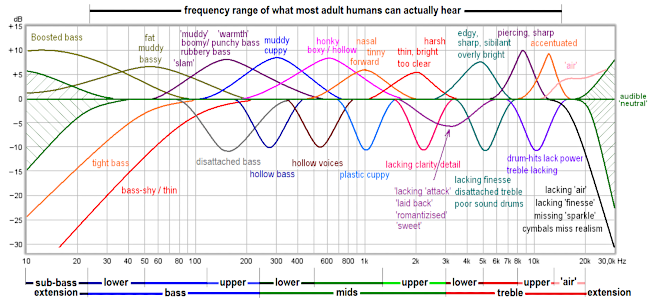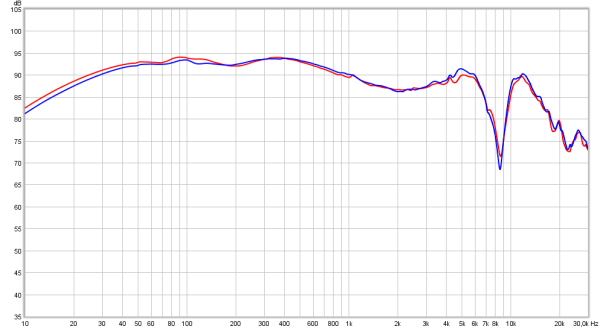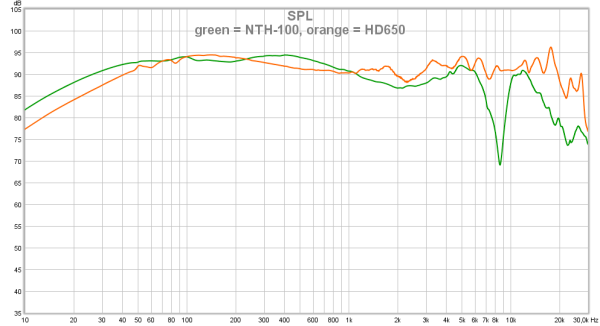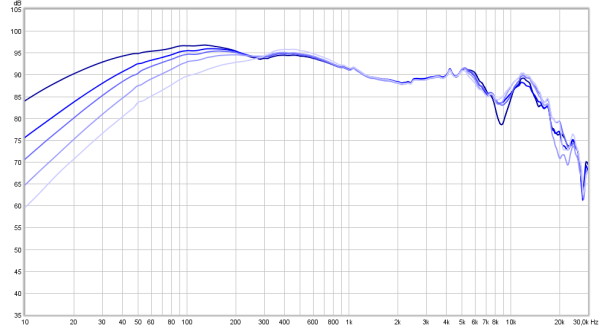Røde NTH-100
published: Apr-02-2022
NO SMOOTHING is applied to the shown plots. Most measurement sites have some smoothing applied which ‘irons flat’ sharp peaks and ‘wiggles’. I do not use smoothing because some info about sound quality is lost when plots are smoothed.
Aside from a small correction of the microphone itself also some correction in the lowest frequencies is applied to the plots to compensate for the perceived loss of bass when using headphones. This is described HERE in more detail.
A ‘horizontal‘ frequency response curve on the shown frequency response plots on this website thus indicates a perceived ‘flat’ tonal signature.
ALL measurements are made with a good SEAL on a flatbed measurement rig.
The shape of your head, bone structure, pad size, pad ‘softness, (compliance), hair or no hair and or wearing glasses may (drastically) change the frequency response of some headphones, so… your personal experience may differ substantially from these plots.
Frequency response (tonal balance) is the most sound-determining aspect of headphones. A horizontal line shows audible neutral response in the plots on this website. Deviations in different severity at different frequency bands have an effect on the sound character.
The bigger the deviation the stronger the effect.
Below an aid to help determining the sound character of headphones with relation to the frequency response.
Røde NTH-100

The Røde NTH-100 is a closed over-ear headphone. It costs around € 180.- ($ 149.-). It comes with a pouch, a 2.4m straight replaceable cable, 6.3mm (1/4″) adapter and a set of colored rings that can be clipped onto the cable. It is targeted at studios. This headphone can also be used with portable gear.
Attenuation from mid and higher outside noises is fine. Low frequencies are also attenuated a bit.
There are a few ways to quickly identify the left and right cup. Inside the cups there is a large L and R, on top of the right ear cup there is a red marking on the cable entry. There are Braille markings near the top of both cups.
The headband is not of a usual design and feels and looks sturdy. It can take a beating which is essential in a studio.
The cups can tilt a little but enough to accommodate for most head sizes.
Height can be adjusted over a 30mm range. Most headphones can adjust over a 40mm range.
The height can be fixed using a twist-lock mechanism. Handy when only one person uses it and you want to grab it and put it on your head. You won’t have to adjust the height.
It can also be used in non locked position and is firm enough that it does not change height easily.
The cups have a little swivel (rotate) as well and just enough for a good fit.
This headband cannot collapse nor fold flat. This means when transporting it (in a soft pouch) it isn’t going to be small.
The headband is padded with fast memory foam covered with ‘Alcanatara’ synthetic fabric which feels like soft suede. The pads are made of the same material. The padding is quite thick and wide enough to not cause discomfort.
The cups are shaped in a triangular-ish shape which means it has a shape that fits around the pinnae.
Most pads are either oval or round and a few are even rectangular. The shape on this headphone is more logical. There are more headphones using this shape so is not unique to the NTH-100.
Another feature is the cable can be inserted in both the left and right cup. This can be handy depending on whether or not the source one has to plug into is positioned on the right or left side.
This dual entry construction can make people believe all it takes is a balanced cable and the headphone can be used from a balanced source. Alas this is not the case as left and right are always connected via a single return wire.
So the cable can be plugged in on either the left or the right side. There is a little snag here though.
I found this out while measuring the headphone and encountering a channel mismatch which reminded me of the Beyerdynamic DT250-250. It turns out the not used plug has to be closed with a special stopper that has a small hole in it. More on this further down. There is only 1 of those plugs supplied. Losing it means you end up with a channel imbalance. So quick swapping the cable from left to right is not going to happen.
One must choose left or right cup. By far the most single entry headphones have the cable going into the left cup but there are very few exceptions.
The cable is 2.4m long. On the headphone side it has a proprietary 3.5mm TRS goldplated locking (twist lock) connector and on the source side a 3.5mm goldplated TRS plug with a screw-on 6.3mm adapter. This means this headphone can not be used with balanced output sources.
The cable feels soft, pliable and does not have an ‘audiophile thickness’.
Unfortunately the cable is microphonic. Touching the cable results in sounds in the left cup. While listening to music it isn’t very distracting. The cable entry is pointing a bit forward so the cable ‘drapes’ a bit in front of you. A few color rings are included so when you have a few of them you can quickly see which one is which.
Røde also sells a 1.2m cable. Both the 1.2m and 2.4m cables are available in pink, blue, green, orange and black
The pads are soft and have a depth of 20mm. The memory foam inside is decently firm and has a less pliable gel between the foam and the cloth cover. It does not compress much when on the head.
The surface area that touches the skin is flat and about 18mm wide. As the pads closely contour the ear there should be a good seal. The pads and headband are replaceable.
The gel layer is there to prevent the pads to feel warm/sweaty.
Weighing 360gram (without cable) and having a, for closed headphones, medium-high clamping force of 5N and the skin surface makes you aware you are wearing headphones. They are certainly not uncomfortable though.
With a sensitivity of 114dB/V (efficiency = 99dB/mW) and low impedance (32Ω measured) this headphone plays decently loud even directly from a phone.
The 1.7W power rating is high enough that it will be hard to blow it up even when playing loud lying on a console.
specifications:
Type: Over ear (circum-aural) closed
Usage: Studio, portable
Driver type: dynamic
Pads: replaceable cloth with firm memory foam and a gel layer, ear-shaped.
Collapsible: no
Headphone cup connector: 3.5mm TS jack, locking
Cable entry: single sided (by choice left or right side)
Cable: 2.4m straight in a gold-plated 3.5mm TRS jack with 6.3mm screw-on adapter.
Inner Pad dimensions: depth = 20mm, width = 36mm, height = 60mm
Driver size: 40mm
Max. power rating: 1.7W
Max. voltage: 7.4Vrms (21Vpp)
Max. current: 230mA
Max. S.P.L.: 130dB
Impedance: 32Ω (measured)
Efficiency: 99dB @ 1mW
Sensitivity: 114dB @ 1V
Weight: 360 g. (without cable)
Clamping force: medium-high (5N)
Accessories: pouch, 6.3mm adapter, color coded rings.
Subjective sound description:
Full bodied sound with tastefully ‘subdued’ clarity and highs lacking some ‘sparkle’, ‘detail’ and ‘finesse’.
The sound is certainly not ‘audiophile’ but it is quite suited for studio usage. Especially monitoring at louder listening levels. When one plans to mix audio-only recordings on these I would recommend to fully ‘learn’ the sound, EQ or maybe end up with trebly recordings but will be perfect for producing videos and spoken word.
For audio reproduction it has a totally non fatiguing and not sharp full bodied sound only lacking in ‘sparkle’, ‘detail’ and ‘finesse’.
Measurements:
Below the frequency response of the NTH-100 (Left, Right) measured at 94dB @ 400Hz. The frequency response does not show many dips and peaks (is remarkably smooth) which is often not the case for closed headphones. This can be seen in the ‘comparisons’ section below. Only around 8kHz there is a dip but the treble response is not ‘ragged’.
The frequency response does not show many dips and peaks (is remarkably smooth) which is often not the case for closed headphones. This can be seen in the ‘comparisons’ section below. Only around 8kHz there is a dip but the treble response is not ‘ragged’.
The channel matching is good. Bass extension there but somewhat rolled off below 30Hz. Flat response from 30Hz to 700Hz. From 700Hz to 3kHz the response is sloping downwards approx.6dB.
This makes the sound ‘full bodied’ but lacking in ‘clarity’. The lower upper mids makes the headphone sound less ‘dynamic’ but ‘powerful’ and voices and instruments are missing ‘attack’ and ‘detail’.
The dip at 8kHz is less in reality. This is in the ‘sibilance’ band and as there is a dip there it is totally devoid of sibilance but unfortunately (as the dip is too deep) also ‘detail’.
Above 12kHz the NTH-100 drops off quickly. At 20kHz the output is -20dB opposite the mids.
As a result this headphone lacks ‘sparkle’ and ‘air’. It sounds (and is) rolled off in the treble.
Cymbals lack ‘impact’ and sound like someone is drumming behind thick curtains.
Specs say: 5Hz – 35kHz and that seems correct when using the -20dB cutoff points. This is often used by headphone manufacturers that post wonderfully extended frequency response numbers without really lying. They just forget to mention (-20dB).
When measuring the NTH-100 I noticed a channel imbalance that was very repeatable between measurements. (Left, Right) There was a few dB difference below 300Hz. It reminded me of the effect of partially closing ports on closed headphones. I have seen ‘leakage’ issues in closed headphones around the cable connector and experimented by plugging the not used socket on the right cup (cable was on the left side).
There was a few dB difference below 300Hz. It reminded me of the effect of partially closing ports on closed headphones. I have seen ‘leakage’ issues in closed headphones around the cable connector and experimented by plugging the not used socket on the right cup (cable was on the left side).
Below the socket open and fully sealed with some rubber. This meant that the socket clearly was meant not to be sealed and doubles as a port.
This meant that the socket clearly was meant not to be sealed and doubles as a port.
This also means that one has to be careful when buying aftermarket replacement cables.
Then I remembered there was a rubber thingy in the box that had the size of the same diameter as the hole in the cup and had a small hole in it. Below the change in tonal balance when used with open socket and with the rubber thingy. Below the NTH-100 with the special ‘cap with hole’ that must be used in the non-used socket which provides the correct ‘leakage’ resulting in a balanced L-R.
Below the NTH-100 with the special ‘cap with hole’ that must be used in the non-used socket which provides the correct ‘leakage’ resulting in a balanced L-R. So alas no quick swapping the cable from left to right as one would also have to swap the rubber ‘cap with hole’. Only one was supplied meaning that when you lose it or are not aware it has to be used you end up with channel imbalance. The hole size is paramount to get the proper frequency response.
So alas no quick swapping the cable from left to right as one would also have to swap the rubber ‘cap with hole’. Only one was supplied meaning that when you lose it or are not aware it has to be used you end up with channel imbalance. The hole size is paramount to get the proper frequency response.
I have seen YT reviews that didn’t even use this rubber cap.
compared to
Most headphone aficionados and studio folks have probably heard the Sennheiser HD650 and know it is considered to be a slightly warmish neutral sounding headphone without sibilance. Some even find it to be on the ‘subdued’ when it comes to treble.
So below the NTH-100 versus the HD650 It is obvious the NTH-100 has a bit more bass extension and the lower mids are a bit emphasized compared to the HD650 which has a small mid-bass boost.
It is obvious the NTH-100 has a bit more bass extension and the lower mids are a bit emphasized compared to the HD650 which has a small mid-bass boost.
The Clarity range is between 1kHz and 5kHz and we can see the clarity on the NTH-100 is a few dB below that of the HD650.
Where the HD650 is essentially ‘flat’ between 300Hz and 3kHz the NTH-100 is sloping about -7dB making the NTH-100 less ‘forward’/’clear’ sounding.
Above 6kHz the difference becomes even bigger. As most people find the treble on the HD650 already subdued and lacking ‘sparkle’ it becomes clear that the treble (at least for hi-fi sound reproduction) is below par and rolled-off above 12kHz. EQ’ing it up did improve the sound a bit but the treble quality is still lacking.
This means fine for studio usage, certainly at higher listening levels but not a really audiophile headphone. It also isn’t marketed as such so not a requirement for the intended market.
Below the NTH-100 versus 17 other known closed (mostly studio) headphones.
phase response
Below the phase response of the NTH-100 (Left, Right) Slow phase shifts are not audible. Sharp changes in a narrow frequency bands may well be audible. The sharp variations above 7kHz and above may well be audible and also (partly) responsible for the lesser treble quality.
Slow phase shifts are not audible. Sharp changes in a narrow frequency bands may well be audible. The sharp variations above 7kHz and above may well be audible and also (partly) responsible for the lesser treble quality.
output resistance / damping-factor
As this is a dynamic headphone the frequency response can be amplifier output resistance dependent when certain higher output resistance amplifiers are used.
Instead of showing impedance plots, which are hard to ‘read’ when it comes to assessing the tonal balance change in the real world, the NTH-100 is measured via a few different resistance outputs (0.2Ω, 10Ω, 32Ω and 120Ω). On a higher output resistance amplifier the output level will be lower of course due to voltage division. To compensate for this the amplifier is cranked up to the same level (12.7dB for 120Ω at 1kHz in this case). This way the plots are overlaid and it is easier to see how the tonal balance changes. Output resistances between the mentioned resistance values will result in tonal changes between those traces. The tonal balance in the bass does not change when a higher output resistance amplifier is used.
The tonal balance in the bass does not change when a higher output resistance amplifier is used.
Even at 120Ω the tonal change is below +1.5dB around 60Hz.
This means that tonal balance won’t be different on most studio devices.
seal
Seal can be an issue with closed-back headphones and some open headphones. Breaking the seal (improper fit on the head) usually means a loss of (sub)bass. This can be caused by hair or glasses between head and pad or head shape combined with stiffer pads.
Perfect seal, seal broken by thin armed glasses, seal broken by thick armed glasses resting against the skin, seal broken by thick armed glasses not resting against the skin. A broken seal definitely has influence on the tonality of this headphone. A small seal breakage is not problematic at all, and not even audible but the worse the seal is the more lower bass will suffer.
A broken seal definitely has influence on the tonality of this headphone. A small seal breakage is not problematic at all, and not even audible but the worse the seal is the more lower bass will suffer.
pad compression
As pads get older (wear) the foam deteriorates and gets softer. The foam used in the pads seems to be good quality so expect them to last longer than Beyerdynamic and Sennheiser pads.
When the foam compresses more acoustic properties change a little and the driver-ear distance changes as well. This can change tonality.
Below the pads (as used normally there is hardly any compression) at 20mm, 15mm and 10mm. When the pads compress a bit more (over time) there is a gradual increase in ‘warmth tilt’.
When the pads compress a bit more (over time) there is a gradual increase in ‘warmth tilt’.
Below the distortion measurements of the NTH-100 (Right channel) at 94dB SPL @ 400Hz The plot above shows the level differences between the signal (upper trace) and the harmonics.
The plot above shows the level differences between the signal (upper trace) and the harmonics.
Most people prefer to see percentages instead of level differences so below the exact same plot except ‘normalized’ to the actual signal and level differences given in percentages. Distortion at 94dB SPL is quite high especially for the odd harmonics (3rd and 5th)
Distortion at 94dB SPL is quite high especially for the odd harmonics (3rd and 5th)
This usually points to compression (very soft clipping). 3% distortion at 94dB for lower frequencies is not very problematic (as in sound degrading).
Below the distortion measured at 84dB SPL (at 400Hz) We can still see rather high 3rd harmonic distortion but it is improved.
We can still see rather high 3rd harmonic distortion but it is improved.
When used for sensible listening levels music enjoyment the distortion levels are good enough not to be audible. Distortion measured at 1kHz is low but then again most headphones are.
Its getting low numbers at low frequencies that is a challenge.
The actual 2nd harmonic distortion above 500Hz may well be lower than 0.2% . A shortcoming of my measurement rig.
compression
The high distortion levels even at lower SPL indicated that there is compression of lower frequencies at higher SPL. Below the compression measurements of the NTH-100 which, not surprisingly, showed SPL dependency in the lower frequency range on levels of 70dB, 80dB, 90dB and 97dB SPL. Compression already starts to occur around 80dB SPL (at around 70Hz). This means that bass level relatively differs from frequencies above 200Hz. At 97dB the bass dropped 3.5dB (relatively).
Compression already starts to occur around 80dB SPL (at around 70Hz). This means that bass level relatively differs from frequencies above 200Hz. At 97dB the bass dropped 3.5dB (relatively).
Below the CSD (waterfall) plot of the NTH-100 (Left and Right are overlaid).  The driver appears to have as good as no long lasting resonances. Only a small and short resonance at 4kHz which will not be audible as the ear canal also resonates at around that frequency.
The driver appears to have as good as no long lasting resonances. Only a small and short resonance at 4kHz which will not be audible as the ear canal also resonates at around that frequency.
Below the Group Delay plot for the NTH-100 (Left, Right) There is just very little pad-bounce at 80Hz and 110Hz. Otherwise no problematic resonances.
There is just very little pad-bounce at 80Hz and 110Hz. Otherwise no problematic resonances.
The dip at 8.5kHz is barely visible.
A different plot is the spectrum plot. This basically is a CSD (Waterfall) plot but viewed from above where the level differences are color coded instead of being in the vertical axis. Also the frequency range of the spectrum plot is wider (from 100Hz instead of 500Hz). The time span is also bigger in the spectrum plots and expired time is shown from below to top where in the CSD the time is shown from rear to front. Below the spectrum plot of the NTH-100 (Left channel)  No problems in this plot. Even the bass decays quickly. A short lived lingering at 1kHz is not an issue. The amplitude dropped there already anyway.
No problems in this plot. Even the bass decays quickly. A short lived lingering at 1kHz is not an issue. The amplitude dropped there already anyway.
Step response
Below the step response plot which, when the sound is balanced and well extended should show a fast rise to around 0dB, (indicating fast driver response) and then should be slightly sloping downwards indicating bass extension. (Left, Right) Bass extension is good given the horizontal part doesn’t drop quickly past 1ms. The initial rise stops at -5dB. It does not overshoot and shows a very neutral response from treble range down to the bass.
Bass extension is good given the horizontal part doesn’t drop quickly past 1ms. The initial rise stops at -5dB. It does not overshoot and shows a very neutral response from treble range down to the bass.
The slow rise the first 400μs shows the ‘slow’ character and lack of treble/speed.
conclusion
The Røde NTH-100 is an affordable and comfortable closed over-ear headphone intended for studio/recording usage.
People that are allergic to sharp treble and prefer somewhat rolled-off treble may well enjoy it for music reproduction. It lacks ‘finesse’ and (sparkly) details and treble quality is not ‘audiophile’ but also never sharp/sibilant nor offensive.
For studio usage these niggles aren’t a problem. I would even say this kind of sound is preferable when monitoring.
It does not have the sharp ‘laser-like’ treble of the often used MDR7506 and DT770, nor the hyped bass of the DT770. This may be a blessing for some. For mixing music I do not think this headphone is really suited that well unless EQ’ed or the user is familiar with it’s sound and the final product.
For producing video etc it will be excellent and give results that are very good with intelligible speech.
The clamping force gave me a mild headache after 2 hours of listening. not really a problem in a studio as one takes off the headphone regularly. For musical enjoyment this could be an issue for some people.
The need to use the ‘rubber plug’ in the not-used socket as well as the microphonic cable are possible downsides.
Build quality is good and seems durable and practical. Very usable in a studio.
Those looking for a closed ‘audiophile’ sound quality headphone should look elsewhere. Too dark and lacking ‘finesse’ and ‘detail’.

Amazing work, thanks.
Oh that pesky dip between 6-10k and no highs above 15k. Despite many say they have good resolution, imaging, and are comfortable due to Alcantara pads. Well…
Just got my pair of NTH-100 unboxed today and i’ve noticed without the stopper (black rubbery thing) the imaging is a bit off to the side without the stopper when resolving the center sound. It resolves when the stopper is plugged
yes, that stopper is really important for sure and easy to miss when one does not know or look in the manual.
The FitLok plastic is too thin and brittle, it has a har crack and finally break apart, Rode offers a replacement and lifetime warranty, but whether they improves the design and the plastic material and thickness, still unknown.